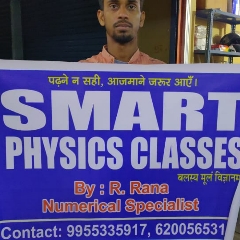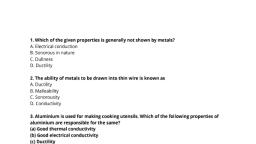Question 1 :
A copper wire has diameter 0.5 mm and resistivity of $1.6×10^{-8}Ω$m. What will be the length of this wire to make its resistance 10 Ω?
Question 2 :
How many 176 ohm resistors (in parallel) are required to carry 5 A on a 220 V line?
Question 4 :
<img style='object-fit:contain' src='https://teachmint.storage.googleapis.com/question_assets/cbse_ncert/61b19d38273b230584979bc3.jpg' /> In the above figure, an electric lamp, whose resistance is 20 Ω, and a conductor of 4 Ω resistance are connected to a 6 V battery. Calculate the potential difference across the electric lamp.
Question 5 :
An electric bulb is rated 220 V and 100 W. When it is operated on 110 V, the power consumed will be
Question 6 :
When a 12 V battery is connected across an unknown resistor, there is a current of 2.5 mA in the circuit. What is the value of the resistance of the resistor?
Question 7 :
An electric motor takes 5 A from a 220 V line. Determine the power of the motor and the energy consumed in 2 h.
Question 8 :
The resistance of an electrical component remains constant while the potential difference across the two ends of the component decreases to half of its former value. What change will occur in the current through it?
Question 9 :
How is a voltmeter connected in the circuit to measure the potential difference between two points?
Question 10 :
What is the commercial unit of electrical energy (Represent it in terms of joules) ?
Question 11 :
A piece of wire of resistance R is cut into five equal parts. These parts are then connected in parallel. If the equivalent resistance of this combination is R’, then what is the ratio $\frac{R}{R^{'}}$?
Question 12 :
State true or false: When connected to the same source the current will flow more easily through a thick wire than thin wire.
Question 13 :
How much power is used in 2$\Omega$ resistor when a 6 V battery is connected in series with 1$\Omega$ and 2$\Omega$ resistors?
Question 14 :
A cylindrical conductor of length l and uniform area of cross-section A has resistance R. Another conductor of length 2l and resistance R of the same material has area of cross section
Question 15 :
Two resistors of resistance $2\Omega \ and \ 4\Omega$ when connected to a battery will have
Question 16 :
<img style='object-fit:contain' src='https://teachmint.storage.googleapis.com/question_assets/cbse_ncert/61b19cd9273b230584979b54.JPG ' />
In the above electric circuit, find out the potential difference across $4\Omega$ resistance .
Question 17 :
<img style='object-fit:contain' src='https://teachmint.storage.googleapis.com/question_assets/cbse_ncert/61b19d39273b230584979bc4.jpg' /> In In the above figure, an electric lamp, whose resistance is 20 Ω, and a conductor of 4 Ω resistance are connected to a 6 V battery. Calculate the potential difference across the conductor.
Question 18 :
A piece of wire of resistance R is cut into five equal parts. These parts are then connected in parallel. If the equivalent resistance of this combination is R′, then the ratio $\frac{R}{R'}$ is?
Question 19 :
Which uses more energy, a 250 W TV set in 1 h or a 1200 W toaster in 10 min?
Question 20 :
In parallel combination of resistors, the current is _____in every part of
the circuit.




























